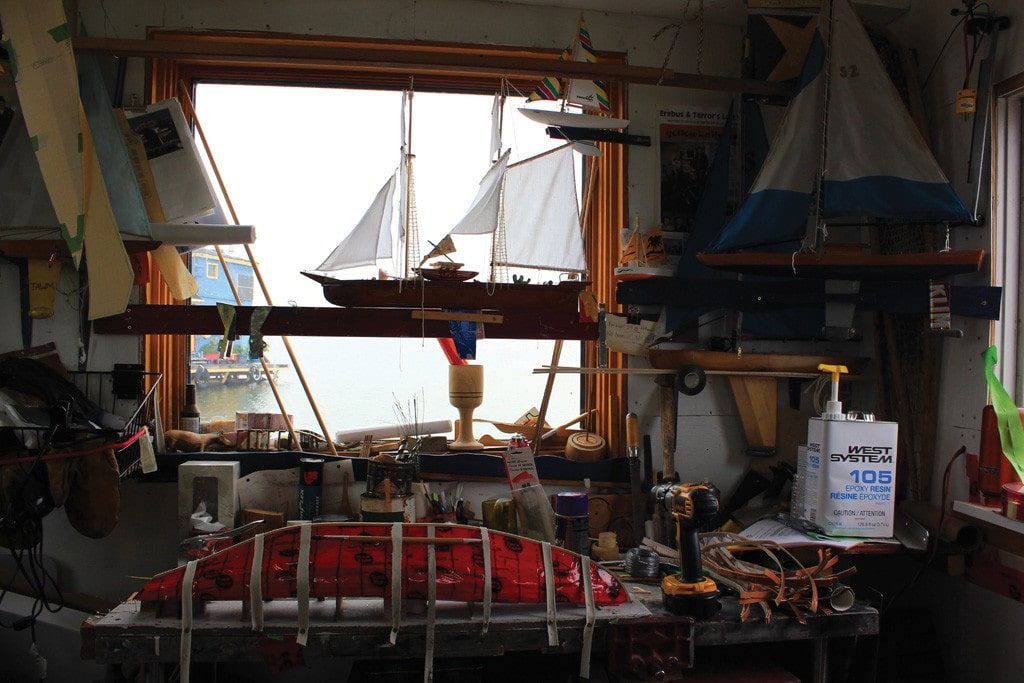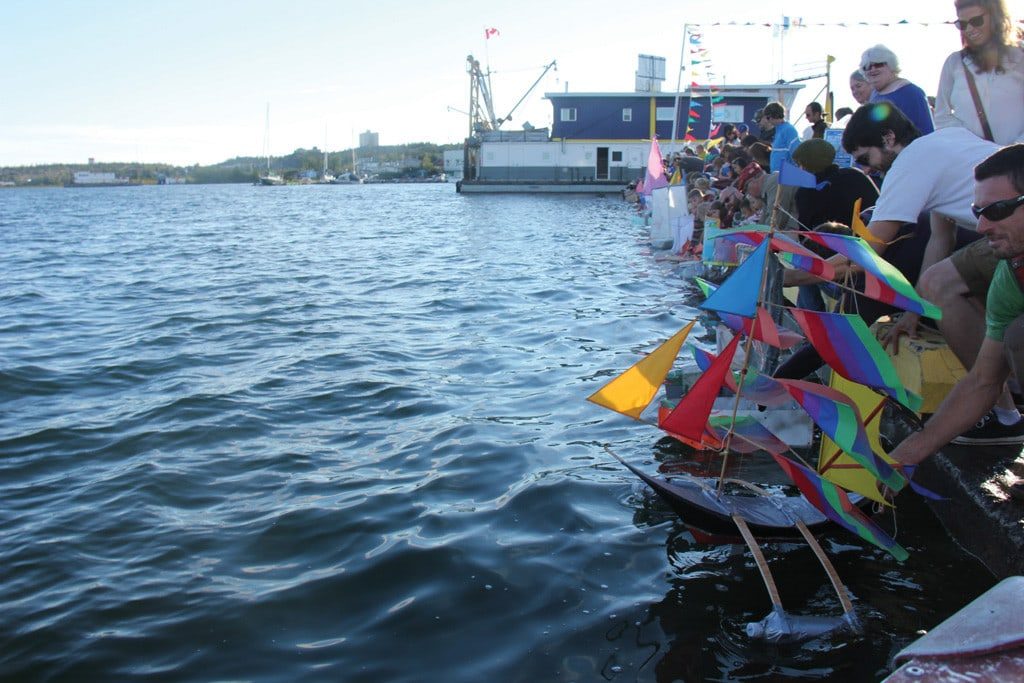If it was a beauty pageant, Lachlan McLean might have won the Old Town Pond Sailors Regatta there and then, hands-down, no contest, race over, trophy awarded. Beside his boat, the other entries looked as slow as the annual beer barge.
A house-boater who made a “joke entry” in a previous regatta, McLean was challenged to build something more race-worthy by Tony Foliot, and felt compelled to equal, if not better Foliot, his neighbour and founder of the annual end-of-summer event.
Foliot showed McLean his planned entry: a 19th century schooner patterned loosely after a vessel that Foliot’s grandfather sailed on the Atlantic coast, between Cape Breton, N.L., and the French islands of St.Pierre and Miquelon.
The schooner is more ambitious than any of Foliot’s previous boats, which had hulls laminated from scraps of wood, sawed and sanded into shape, with keels of salvaged sheet metal and hammered lead fish weights for ballast. The schooner’s hull is shaped with strips of birch bark and red tuck tape. Pinned to a board in the waterfront shack where the Old Town Scrabble League meets to drink and smoke and cheat and lie, the upturned vessel looks like the chrysalis of a tropical moth.
Inspired, McLean scoured the internet for designs.
He fastened on the Endeavour, a J-Class America’s Cup contender from the ‘30s. An architect friend drew a set of plans to pond scale and McLean set to work constructing a hull with a carbon-fibre skin.
The result was a sleek black vessel with crisp polyethylene sails. It might have been lifted from the pages of Model Yachting Magazine, or any one of a dozen other publications devoted to the interests of a global audience. In the wide world beyond Yellowknife Bay, model yacht building and racing are a big deal. Enthusiasts with $1,000 to spend can sign up for a six-day course at the Wooden Boat School in Brooklin, Maine. Or they might tap into free websites that offer step-by-step instruction for boats simple enough to build over a weekend – which is more in line with Foliot’s vision for the regatta.
Foliot resumed building boats after the birth of his first grandson, Simon, prompted by the memory of the fun he had with boats he built with his father. His were patterned after the America’s Cup winners of an earlier era, before they took on the appearance of aircraft/hydrofoil hybrids with every motion monitored, analyzed and directed by computers.
The regatta was conceived as a family event. Foliot says its purpose is to “encourage creativity and inclusion – families working together. It fosters a sense of accomplishment that can’t be duplicated by a high-tech gadget or game,” hence the guiding rules: no electronic guidance, and every vessel must include recycled material.
Over the regatta’s first five years, Larry Jones has emerged as Foliot’s chief rival. At his day job, Jones is manager of construction and infrastructure services for the NWT Housing Corp. He has a lifetime of experience with wood and tools. After watching his grandsons Kym and Ashley Kanatsiak sail Foliot’s boats to victory, Jones decided he would help them build their own. First time out, they took the top two spots.
Jones lofts his plans from one-metre class pond boats, which are based on America’s Cup winners, but he pays particular attention to Frank Russell’s designs. Russell, an Australian, builds pond yachts for an international market. A bare Russell hull sells for $400 AU, a complete boat $1,850 AU. The sub-Arctic winter is the perfect time to build boats and Kym and Ashley are eager. Ashley has enjoyed success with Ducky I and Ducky II, boats that benefited from flotation provided by rubber ducks that lined their rails. He wants to build Ducky III, but this time as a square-rigged pirate ship. Kym has a catamaran in mind, one rigged from plastic bottles – probably Tide, because Jones likes their shape – and tied together with clothes hangers, with sails of fabric taken from an umbrella that was blowing down Franklin Avenue.
“A catamaran presents special challenges to the pond sailor,” says Jones. “They need a lot of human intervention to sail properly, but the rules allow just one adjustment. I may have to come up with a steering mechanism that ties in with the sail.”

Tony Foliot’s east coast schooner remains a work in progress, in the boat shed that also hosts weekly scrabble games.
Classic pond boats of the type Foliot and Jones have built track naturally into the wind. With that in mind, and to give less formal entries a chance, Foliot deliberately places the finish line down wind.
Setting the sail and rudder are critical and skippers get just one chance, before they launch their boats and fates to the elements. The rule is a tip of the commodore’s hat to Sarah Taggart Miles, whose name is the first name etched on the regatta trophy.
“That very first race all of us had nice wooden boats that we built, and this little girl showed up with a plastic milk jug that she had cut in half, with duct tape to make a deck, and little paper sail,” Foliot recalled.
“When we put our boats in, we went tacking this way and that with the wind. She had no keel or rudder, and scudded all the way to first. We all had our asses handed to us by this little girl. It was the best way to start the festival.”
The win by a vessel that owed more to ingenuity and whimsy than nautical tradition kept the door open to the last-minute, slap-dash shipwrights who launch an armada of weird and wonderful boats that comprise most of the regatta entries.
After watching his zucchini boat sink at the dock, Steve Woolf was back for the fifth annual regatta, with a houseboat fashioned from an old fruit box, with a door stop for a rudder. It scudded along the dock for a few feet, then heeled over on its side.
City Councilor Dan Wong’s first regatta entry was a promising piece of Styrofoam found at the dump and swathed in duct tape. It immediately capsized and wallowed at the dock.
Known to make cute boats that didn’t sail, Stephan Folkers decided that “I better make one that’s going to kick ass.” He carved and polished a block of cedar until he was satisfied with the shape and shine, then added a keel and rudder hammered from shelf brackets and canvas sails.
“I had it out in the water this afternoon and it goes like snot, and it knows which way to go,” Folkers said before launching the Cohiba on its first race.
The boat started smartly, heading for the finish line in the lee of Jolliffe Island, then turned into the brisk southwest breeze and headed for Hay River.
McLean’s Endeavour fared no better. It was barely beyond the shadow of the dock when a Foliot boat skippered by Laura Hodgins breezed across the finish line. But he beat the schooner, which remains pinned to its board in the Scrabble shack, a new season to break out.







